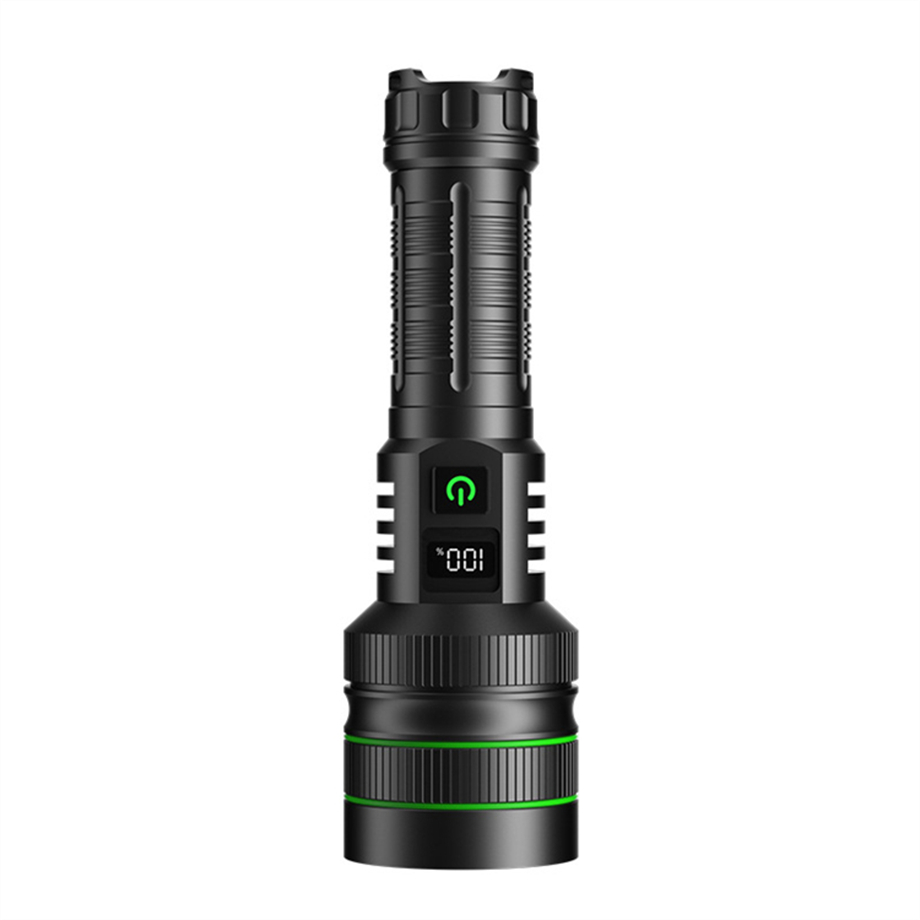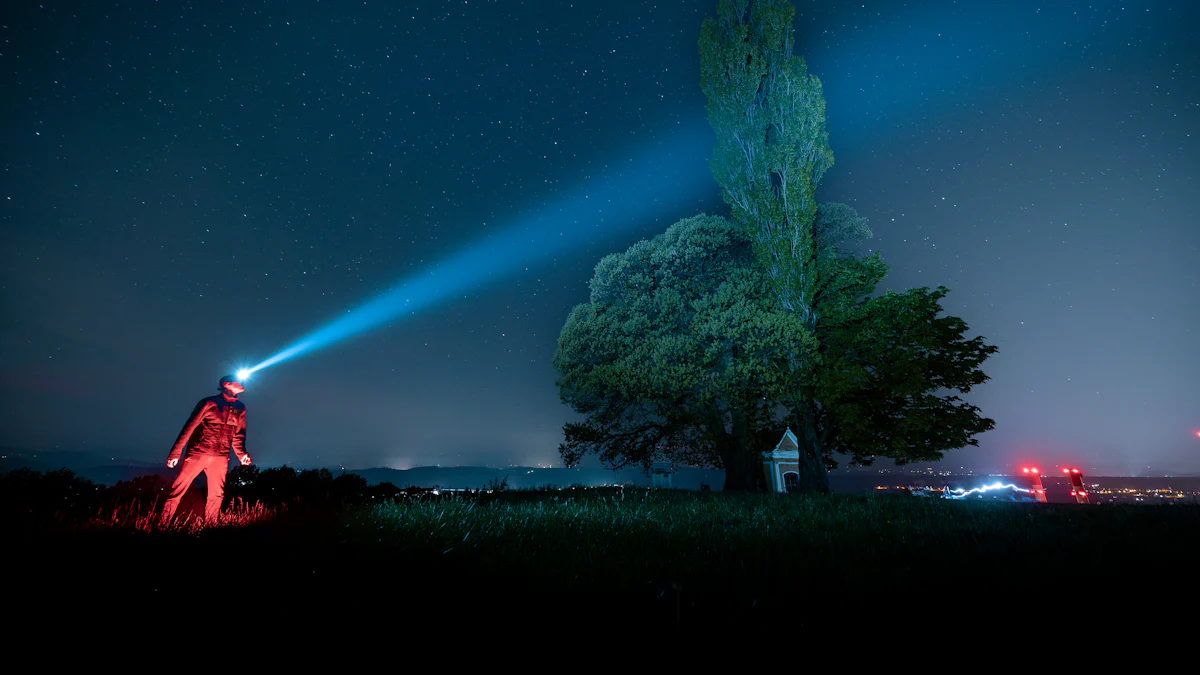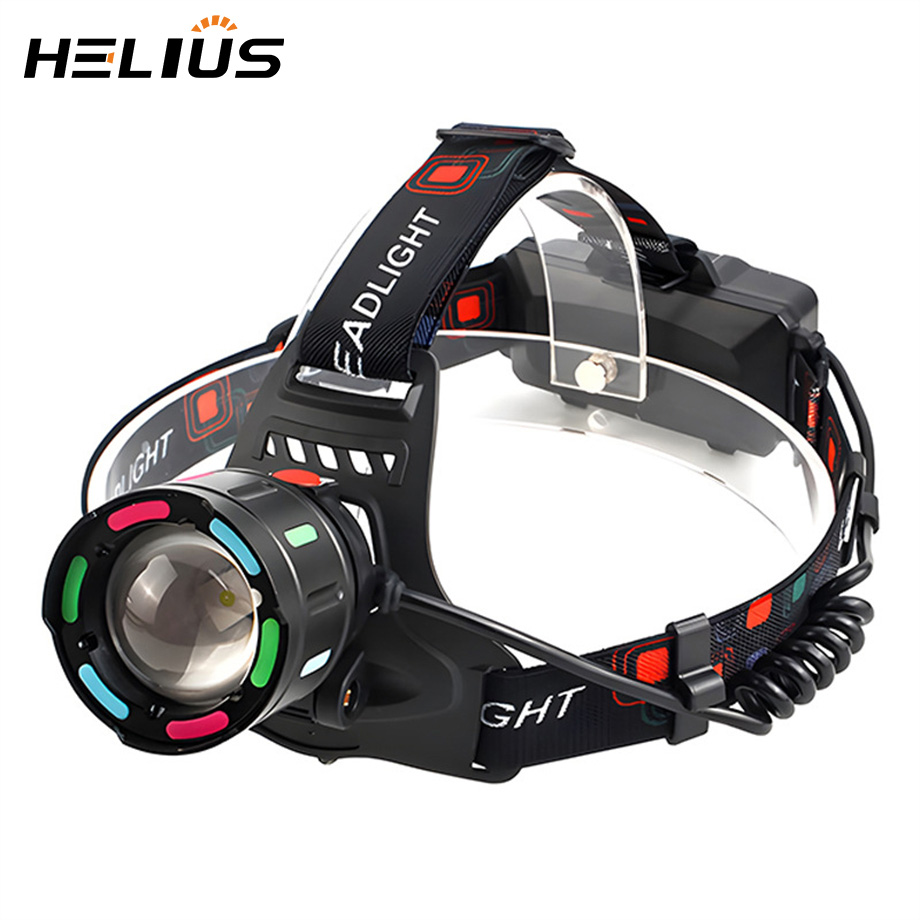How to Choose Flashlights Made of Durable Materials for Harsh Outdoor Environments

When you venture into harsh outdoor environments, knowing how to choose flashlights made of durable materials for harsh outdoor environments becomes essential for ensuring you have a reliable companion. Low-quality flashlights often fail under extreme conditions, leaving you vulnerable to darkness and potential hazards. A sturdy flashlight ensures you stay prepared, whether you're navigating rugged trails or enduring unpredictable weather.
Durability matters because outdoor activities demand tools that withstand challenges. Features like waterproofing, shockproof design, and extreme temperature resistance are critical. For example, waterproof flashlights function in wet conditions, while shockproof models survive accidental drops. The table below highlights these essential features:
Feature | Importance in Harsh Environments |
|---|---|
Waterproof | Ensures functionality in wet conditions |
Shockproof | Protects against drops and impacts |
Extreme Temperature Resistance | Maintains performance in varying weather conditions |
Choosing the right flashlight enhances your safety and performance. It provides dependable illumination, helping you focus on your adventure instead of worrying about equipment failure.
Key Takeaways
Pick flashlights made of strong materials like aluminum for durability and easy carrying.
Check for waterproof ratings, like IP68, to make sure it works in rain or wet places.
Go for shockproof designs to keep it safe from falls and bumps during outdoor adventures.
Think about how bright it is, measured in lumens, to fit your outdoor needs, whether for fun or emergencies.
Choose rechargeable batteries, like lithium-ion, for longer use and better performance in hot or cold weather.
Key Features of Durable Outdoor Flashlights

Material Strength and Build Quality
When choosing an outdoor flashlight, you should prioritize material strength and build quality. These factors determine how well the flashlight can endure rugged conditions. Manufacturers often use high-quality materials like aluminum and stainless steel. Aluminum is lightweight yet strong, making it ideal for long-lasting use during outdoor adventures. Stainless steel, on the other hand, offers greater hardness and durability, though it is heavier. Many outdoor flashlights use aluminum alloy because it combines strength with low density, ensuring both durability and portability.
A flashlight with excellent build quality will also feature precision engineering. This ensures that all components fit securely, reducing the risk of damage from impacts or environmental exposure. By selecting a flashlight made from robust materials, you can trust it to perform reliably in harsh environments.
Waterproofing and Weather Resistance
Outdoor conditions can be unpredictable, so a waterproof flashlight is essential. The industry uses the IP rating system to measure water resistance. For example, flashlights with an IP68 waterproof rating can withstand significant water exposure, including submersion. The second digit in the IP rating indicates the level of water protection, with higher numbers offering better resistance.
Brands like Fenix design their outdoor flashlights to meet these high standards, ensuring they perform well in rain, snow, or even underwater. A waterproof flashlight not only protects its internal components but also ensures consistent LED performance in wet conditions. This feature is critical for maintaining visibility and safety during outdoor activities.
Impact Resistance and Shockproof Design
Durability also depends on impact resistance and shockproof construction. Shock-resistant flashlights are designed to survive accidental drops without compromising functionality. Many models meet ANSI/NEMA FL-1 standards, which require flashlights to endure six test drops from a height of one meter.
These flashlights often include additional features like abrasion resistance and water protection, enhancing their overall durability. When you invest in a flashlight with shockproof construction, you gain confidence that it will withstand the physical demands of outdoor use. This makes it a reliable companion for hiking, camping, or emergency situations.
Essential Considerations for Choosing the Best Flashlights
Brightness and Beam Distance
When selecting an outdoor flashlight, brightness and beam distance are critical factors. Brightness, measured in lumens, determines how much light the flashlight emits, while beam distance indicates how far the light reaches. For general activities like hiking or camping, a flashlight with 100 to 400 lumens provides sufficient illumination. Tactical or search-and-rescue operations require a high-lumen flashlight with 1,000 to 2,000 lumens for maximum visibility. Everyday tasks, such as walking at night, only need 50 to 200 lumens.
The table below summarizes the ideal brightness and beam distance for various outdoor activities:
Lumens | Distance | Best For |
|---|---|---|
1–250 | Up to 80 meters | Everyday and leisure activities |
160–400 | Up to 100 meters | Camping, hiking, backpacking |
400–1000 | Up to 200 meters | Caving, engine repair |
1000–30000 | Up to 350 meters | Fishing, hunting, climbing |
3000–70000 | Up to 500 meters | Emergency rescue, mountaineering |
Choosing the right brightness ensures you have clear visibility without draining the battery unnecessarily.
Battery Type and Longevity
Battery life plays a significant role in the performance of outdoor flashlights. Different battery types offer varying levels of longevity and reliability. Alkaline batteries are affordable and widely available but drain quickly. Lithium-ion batteries, known for their long battery life, provide superior energy density and perform well in extreme temperatures. Nickel-metal hydride (NiMH) batteries are rechargeable and eco-friendly but may self-discharge if unused for long periods.
Here’s a quick breakdown of battery types:
Alkaline Batteries: Budget-friendly but short-lived.
Lithium-Ion Batteries: Long-lasting, lightweight, and ideal for high brightness flashlights.
NiMH Batteries: Rechargeable and environmentally friendly but prone to self-discharge.
For outdoor adventures, lithium-ion batteries are often the best choice due to their durability and long battery life.
Size, Weight, and Portability
The size and weight of your outdoor flashlight affect its portability. A compact and lightweight flashlight is easier to carry during long hikes or camping trips. However, smaller flashlights may sacrifice battery life or brightness. Tactical flashlights often strike a balance between size and performance, offering high brightness in a portable design.
Consider your activity when choosing the best flashlights. For example, a compact flashlight works well for everyday carry, while a larger model with extended battery life suits extended outdoor trips. Prioritizing portability ensures you can carry your flashlight comfortably without adding unnecessary bulk to your gear.
Additional Modes and Functional Features
When choosing a flashlight for outdoor use, additional modes and functional features can significantly enhance its versatility. These features allow you to adapt the flashlight to different situations, making it a more practical tool for your adventures.
One essential feature to look for is multiple lighting modes. Many flashlights offer settings like low, medium, and high brightness. These modes let you adjust the light output based on your needs. For example, a low mode conserves battery life during extended use, while a high mode provides maximum illumination in emergencies. Some models also include a strobe mode, which can disorient potential threats or signal for help.
Another valuable feature is a red light mode. Red light preserves your night vision, making it ideal for stargazing or navigating in the dark without disturbing wildlife. This mode is especially useful for campers and hunters who need to maintain a low profile.
Some flashlights come with a zoomable beam. This feature allows you to switch between a focused spotlight for long-distance visibility and a wide floodlight for illuminating larger areas. A zoomable beam adds flexibility, ensuring you have the right lighting for any task.
You should also consider flashlights with built-in rechargeable batteries and USB charging ports. These features eliminate the need for disposable batteries and make recharging convenient, especially during multi-day trips. Some models even include power bank functionality, letting you charge other devices in emergencies.
By selecting a flashlight with these additional modes and features, you can ensure it meets the demands of various outdoor activities. These enhancements not only improve functionality but also increase the overall value of your flashlight.
Comparing Outdoor Flashlight Types

Tactical Flashlights for Rugged Use
Tactical flashlights are built for reliability in demanding situations. These flashlights often feature a rugged design, making them ideal for outdoor adventures or emergency scenarios. They prioritize simplicity and ease of use, ensuring you can operate them under pressure. Unlike everyday carry (EDC) flashlights, tactical models focus on essential functions.
Tactical flashlights provide instant access to strobe or turbo mode, which is crucial for self-defense or signaling.
They avoid unnecessary features like Bluetooth or USB charging, which can complicate use during emergencies.
Their durable construction ensures they withstand harsh conditions, making them a dependable outdoor flashlight for critical tasks.
If you need a flashlight that performs consistently in rugged environments, a tactical model is a great choice. Its straightforward design and robust build make it a reliable companion for outdoor activities.
Headlamps for Hands-Free Convenience
Headlamps offer unmatched convenience when you need both hands free. Whether you're hiking, cooking outdoors, or searching for gear in your tent, a headlamp provides practical illumination.
Whether you’re trail running, cooking outdoors, or trying to find something in your tent, you can’t beat the hands-free convenience of a headlamp.
These lights are lightweight and adjustable, ensuring a comfortable fit for extended use. Many headlamps also include multiple brightness settings, allowing you to adapt to different tasks. For example, a low setting works well for reading maps, while a high setting provides visibility on dark trails. If you value portability and ease of use, a headlamp is an excellent addition to your outdoor gear.
Lantern-Style Flashlights for Broader Illumination
Lantern-style flashlights excel at providing wide-area illumination. These lights are perfect for group activities like camping or picnics, where you need to light up a larger space. Unlike a traditional camping flashlight, which focuses on a single beam, lanterns distribute light evenly in all directions.
Many lanterns include features like dimming options and rechargeable batteries, making them versatile for various outdoor settings. Some models even double as power banks, allowing you to charge your devices during extended trips. If you're planning a group outing or need a reliable light source for your campsite, a lantern-style flashlight is a practical choice.
Practical Tips for Selecting the Best Flashlights
Budget-Friendly Options Without Compromising Durability
Finding a flashlight that balances affordability and durability is possible. You don’t need to overspend to get a reliable flashlight for outdoor use. Look for models made from aluminum alloy or other sturdy materials. These materials provide strength without adding excessive cost. Many budget-friendly flashlights also include essential features like waterproofing and impact resistance.
Rechargeable flashlights often save money in the long run. They eliminate the need for disposable batteries, which can add up over time. Some affordable options even offer multiple light modes, allowing you to adjust brightness based on your needs. By focusing on quality materials and practical features, you can find a flashlight that fits your budget without sacrificing performance.
Trusted Brands and Warranty Considerations
Choosing a flashlight from a trusted brand ensures you get a product that meets high-quality standards. Brands like Fenix, Streamlight, and Olight are known for their durable designs and reliable performance. These companies often test their products rigorously to ensure they withstand harsh conditions.
A good warranty adds extra peace of mind. Many reputable brands offer warranties that cover manufacturing defects or performance issues. When comparing options, check the warranty terms. A longer warranty often indicates the manufacturer’s confidence in their product. Investing in a flashlight from a trusted brand with a solid warranty ensures you get a dependable tool for your outdoor adventures.
Evaluating Reviews and Testing Flashlights
Reading reviews and testing flashlights helps you make an informed decision. Reviews often highlight real-world performance, giving you insights into brightness, battery life, and durability. Look for feedback on how well the flashlight performs in outdoor conditions.
When testing a flashlight, focus on key factors:
Brightness and beam distance. A brighter flashlight with a longer throw works well for hiking or camping.
Runtime. Check how long the flashlight lasts on high settings.
Durability. Drop the flashlight from a reasonable height to see if it remains functional.
Water resistance. Test it in wet conditions to ensure it withstands rain or splashes.
Testing these aspects ensures you choose a flashlight that meets your needs. A reliable flashlight should perform consistently, even in challenging environments.
Choosing a durable flashlight ensures you stay prepared for any outdoor challenge. Key features like high-quality materials, waterproofing, shockproof design, and temperature resistance make a flashlight reliable in rugged conditions.
To find the right flashlight for your activity, consider these tips:
For fishing, choose a flashlight with strong waterproofing.
For hunting, select one with a red-light mode to avoid disturbing wildlife.
For running, prioritize lightweight models with high visibility.
For geocaching, opt for compact designs with adjustable brightness.
Always prioritize quality and functionality over cost. A well-built flashlight with ergonomic design and versatile features will serve you better in the long run, ensuring safety and performance in any environment.
FAQ
What is the best material for a durable outdoor flashlight?
Aluminum alloy is the best choice. It combines strength and lightweight properties, making it ideal for outdoor use. Stainless steel offers more durability but adds weight. Choose based on your activity needs.
How do I know if a flashlight is waterproof?
Check the IP rating. An IP68 rating ensures the flashlight can handle heavy rain or submersion. Always verify the manufacturer’s specifications for water resistance before purchasing.
Which flashlight type is better for camping: headlamp or lantern?
Headlamps work best for hands-free tasks like setting up tents. Lanterns provide broader illumination, ideal for group activities. Choose based on whether you need focused or wide-area lighting.
How many lumens do I need for hiking at night?
For night hiking, 200 to 400 lumens provide sufficient brightness. This range ensures clear visibility without draining the battery quickly. Opt for a flashlight with adjustable brightness for flexibility.
Can I use rechargeable batteries for outdoor flashlights?
Yes, rechargeable batteries like lithium-ion are excellent for outdoor flashlights. They last longer and perform well in extreme temperatures. Many flashlights now include USB charging for added convenience.
Tip: Always carry a backup battery or power bank for extended trips.
See Also
Finding The Ideal Flashlight Or Headlamp For Outdoor Fun
Tips For Selecting Quality Flashlights For Bulk Buying
Essential Tips For Picking The Right Flashlight For Outdoors
